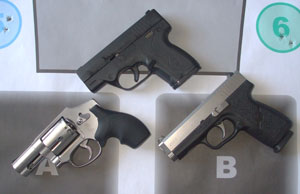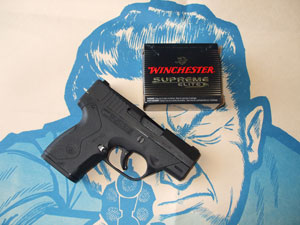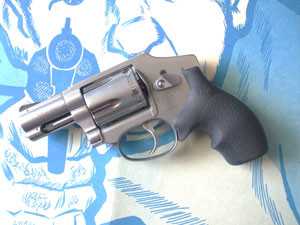There are many things that I like about my job. Teaching at Black Wing Shooting Center, handling new guns and gear, and learning from courses, articles, videos, podcasts and blogs by some of the best in the business. Heck, I’m lucky enough to put an article of my own up from time to time. But there is a very specific downside to doing what I do: I call it carry-gun complacency.
Not complacency from a safety perspective, mind you, but from a practicality perspective. It’s like this: I spend a lot of time carrying a gun and, while that has given me a high level of comfort, it has also likely caused me to become a bit unrealistic in my expectations of everyday carry in public. After all, I am expected to be wearing a gun at work. And since I can carry pretty much whatever I want, I am most often seen with a Glock or Smith & Wesson M&P, most likely nestled comfortably behind my hip in a Kydex paddle holster. But as much as I like my G19 and as much as it pains me to admit it, I found myself on the hunt for a smaller pistol, an everyday carry alternative. The search unexpectedly produced not one gun but three, and each was integrated into the plan in a different way.
Downsizing Criteria
Let’s first take a look at my choice for a downsized defensive gun. I went straight back to my own advice and revisited a few pistols about which I had previously written. I applied some simple but important criteria: above all, the pistol must be reliable. A gun that won’t cycle our defensive ammo of choice with unerring regularity is not to be entrusted with the most important job in the world. But reliability is a two-way street. The most formidable pistol ever conceived won’t be of much use if the operator is insufficiently trained or becomes confused under stress. For this exact reason, I decided that the next requirement was compatibility. The new pistol must use the same operating system as the guns I have carried and trained with, day in and day out, for years. For me, this means a striker-fired semi-automatic pistol with a traditional push-button magazine release and no manual safety or other unnecessary controls. Lastly, I wasn’t looking to do this all over again later, so the new gun had to be considerably smaller than my Glock 19.
After looking over my options, I chose the Beretta BU9 Nano in 9mm, the first modern striker-fired offering from this legendary arms maker. The second pistol produced by this process happened because my wife was also interested in finding a more compact carry option. She too stayed with her familiar striker-fired system, opting for the Kahr CW9, a popular and well-regarded 9mm. What’s important here isn’t so much which guns we chose but the fact that these two new pistols were integrated into our daily use in very different ways.
Beretta BU9 Nano
The Beretta was purchased as a brand-new gun … and not one that has a lot of history behind it. It therefore required a pretty thorough wringing out before being declared trustworthy. At a minimum, any break-in and testing regimen should consist of a couple hundred rounds of practice ball ammo and a good 50 — if not more — of full-power hollowpoint defensive ammo. With no problems observed, this demonstrates good reliability. My personal Beretta Nano did this, and more, before being approved. I had also spent a good deal of time with a Beretta Nano rental gun — seeing it in use with numerous students — long before deciding to pick one up for myself.
Kahr CW9
My wife Julie took a different approach with her Kahr CW9. It went into service much more quickly than did the Nano, but for a very good reason. It is a used gun, purchased as a consignment sale from a trusted source. The previous owner is known to us, so we were satisfied that the gun had undergone a proper break-in and found to be free of defects or mechanical problems. The range sessions with the Kahr were more of a “getting to know you” experience as opposed to an exhaustive high-volume test. Enough to know what it would do and how it liked the carry loads, but not much more. After these fully expected successes, the Kahr CW9 slipped into a belly band and its new role as reliable little sister to Julie’s Springfield Armory XD9.
Smith & Wesson Model 640
Just as this whole process was beginning, an arrangement made some time before came to a conclusion, happily depositing yet another alternate carry gun into our family. In other words, I had agreed to a trade and at last my new gun arrived! This time we were dealing with something completely different. The gun in question is a Smith & Wesson Model 640, chambered in .357 Magnum caliber. For those who don’t carry around a mental catalog of the nearly endless variety of Smith & Wesson handguns, I will summarize. The 640 is a five-shot J frame (small) revolver, built entirely of stainless steel, with a very short (1 7/8 inch) barrel and a completely internalized hammer.
My favorite thing about .357 Magnum revolvers is that they are the ideal platform from which to launch .38 Special bullets. I personally believe that the increase in power offered by the Magnum loads, while impressive, is simply not worth the recoil and muzzle flip. This is particularly true when talking about a defensive situation, where I may very urgently need rapid follow-up shots. Add in the small grips and short barrel of a gun like the 640, and it becomes a serious consideration indeed.
So now we have a defensive handgun that was integrated into the carry lineup with virtually no effort given to “break it in” or “smooth it out” or anything else. Those concerns had already been addressed by someone who’s made a name … and a living … out of making ordinary revolvers extraordinary. Fact is, I don’t lose too much sleep about our revolvers not working properly as they are — and to have had Grant Cunningham pronounce this one fit simply sealed the deal. I freely admit it doesn’t get shot much — mostly so that my friends and I can smile at how smooth and consistent a superbly tuned double-action-only trigger can be.
Summing Up
In all practical terms, Julie and I simply did what was needed to establish reliable function in a trio of pistols. It’s worth noting that we did not deviate from our “orient muzzle toward bad guy and press trigger — repeat as needed” pistol operating drill with these guns. Under stress, adding to the middle of that drill “you might have to move the safety lever to the off position before pressing the trigger, depending on which gun you’re carrying” is undesirable, to say the least. “Ask your doctor if getting killed trying to remember where the buttons are is right for you.” Consistency in training is good, and equipment that allows consistent behaviors is vital. Avoid switching between safeties, oddly placed magazine releases, decocking levers, and the like. Find a reliable system and learn to use it!
There is no way to determine with absolute certainty that a given machine is incapable of failure. So we put a huge amount of emphasis on what we perceive to be “demonstrated reliability.” No matter how many rounds we’ve fired through a gun, no matter how frequent our practice or how thorough our maintenance rituals, things can still go wrong. The whole point of this piece is to suggest that, although we need to have some kind of sensible standard procedure for vetting our defensive guns, there are circumstances under which that procedure can be modified. We should also never lose sight of the fact that as the shooters, we are a vital piece of the reliability puzzle. And it is good, realistic training that we need to bring to the table.




Share tips, start a discussion or ask other students a question. If you have a question for the instructor, please click here.
Already a member? Sign in
No Responses to “Welcome to the Family: Integrating New or Alternate Carry Guns”